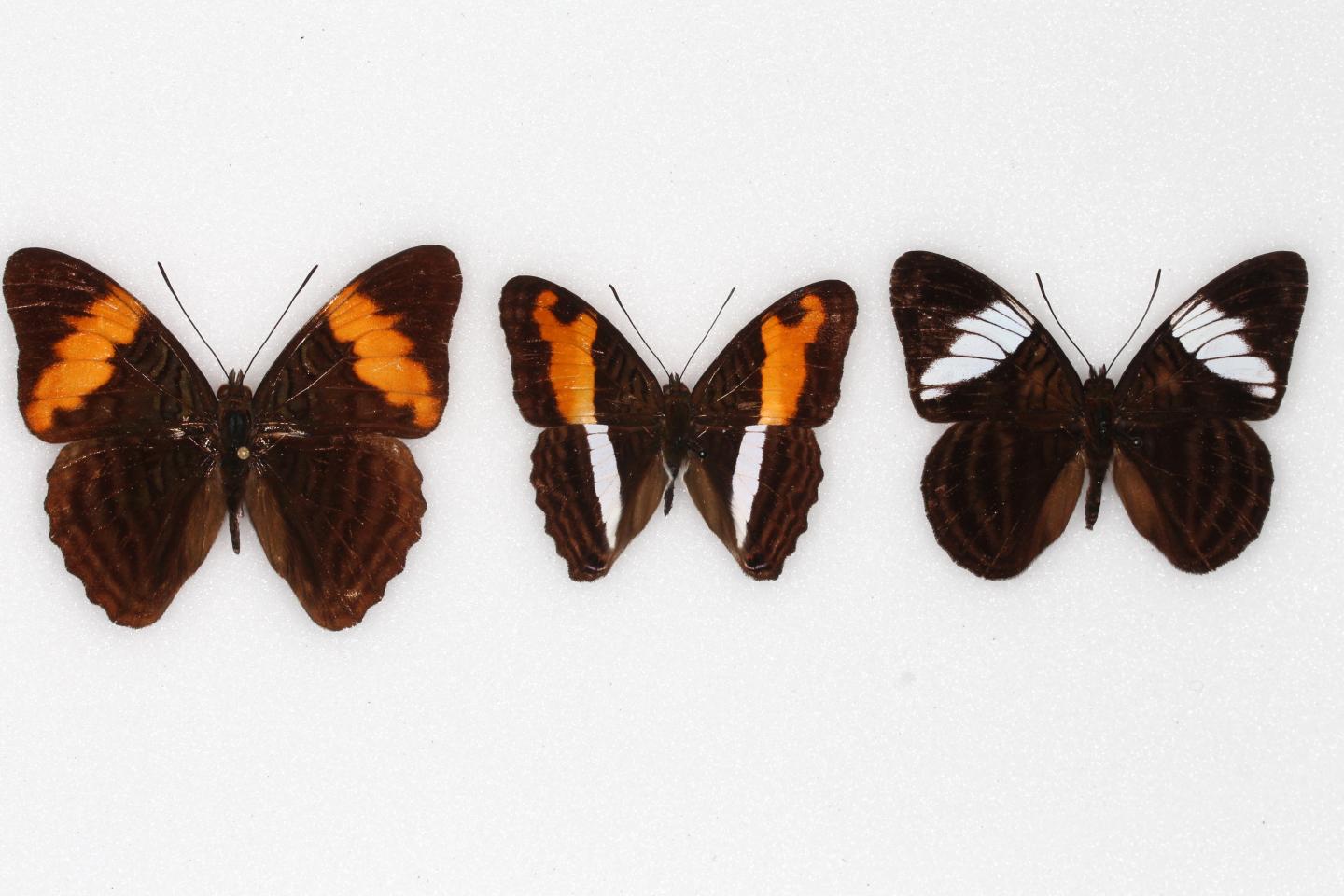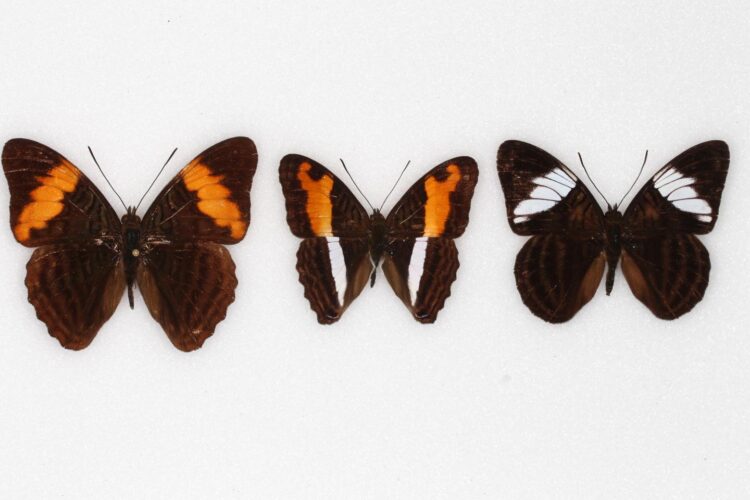
Credit: Jeff Gage/Florida Museum of Natural History
GAINESVILLE, Fla. — The showy colors of some butterflies could advertise their speed and nimbleness, much like a coat of bright yellow paint on a sports car. A new study shows birds can learn to recognize these visual cues, avoiding not only butterflies they’ve failed to nab in the past but similar-looking species as well.
The research provides some of the strongest evidence to date for the idea of evasive mimicry, a strategy in which animals protect themselves from predators by matching the colors or patterns of agile relatives. First proposed more than 60 years ago, the hypothesis has been a challenge to test.
But in an experimental setting, researchers found that wild birds learned and remembered the wing patterns of artificial butterflies that evaded their attacks, as well as those that had a foul flavor, equally spurning both in follow-up tests and often ignoring lookalikes with similar color patterns. Unexpectedly, the birds learned to avoid evasive butterflies faster than distasteful ones.
The results suggest that being hard to catch may deter predators at least as effectively as chemical defenses.
“There’s a common idea that being distasteful is one of the best kinds of defense to have, but at least in this experiment, that didn’t prove to be the case,” said study co-author Keith Willmott, curator and director of the Florida Museum of Natural History’s McGuire Center for Lepidoptera and Biodiversity.
Most research on warning coloration has focused on species with chemical defenses and those that mimic them. Monarch butterflies, for example, sport bright wing patterns of black lines on a field of orange, indicating they contain bad-tasting toxins. A predator that eats one will likely avoid both monarchs and the similar-looking viceroy butterfly in the future.
But a growing number of studies suggest a flashy exterior can mean something entirely different: that an animal is quick. Predators learn to associate these kinds of patterns with a futile chase that leaves them hungry, and species that evolve imitations of these “racing stripes” can capitalize on a defensive strategy while reinforcing the visual message.
“When many species share the same color pattern, they’re better able to educate predators to avoid them,” Willmott said. “The more species that share it, the better.”
During his Ph.D. studies, Willmott worked on the classification of a group of fast-flying tropical butterflies known as Adelpha. At first, he found them nearly impossible to identify. It seemed the genus either contained only a few species with slight variations in wing pattern or dozens of species that looked virtually the same. The latter turned out to be the case, with more than 90 species making up the group. Like some researchers before him, Willmott began to wonder whether evasive mimicry could explain why so many species of Adelpha looked alike.
“It was always mysterious to me,” he said. “Species whose upper wings looked incredibly similar were distantly related, and we started to see cases where even subspecies of multiple species suddenly developed very unique color patterns. Really, the only way you can explain that is through mimicry.”
While other researchers suggested some Adelpha must have hidden chemical defenses, the explanation didn’t quite satisfy Willmott. Toxic butterflies are usually slow fliers with long wings and a propensity for playing dead when caught. Adelpha butterflies, however, don’t display these traits, having instead a short, stout thorax and smaller, triangular wings – characteristics that enable fast, erratic flight and sharp turns.
But he wasn’t sure how to test this hypothesis until a conversation with fellow researchers at a 2018 conference in India: Johanna Mappes was an expert at developing predator-prey experiments with wild birds; Pável Matos-Maraví was interested in the evasive behavior of skipper butterflies; and Marianne Elias and her Ph.D. student Erika Páez were eager to study what drove the evolution of wing color patterns in the genus Adelpha, including the possible effects of predators.
Simulating how evasive mimicry might play out in the wild appealed to the group. The ability of prey to escape predators’ attacks has been “virtually unstudied,” said Elias, a research group leader at the Institute of Systematics, Evolution, Biodiversity at the National Museum of Natural History in France.
Previous work had shown birds can identify the visual cues of evasive prey. Together, the team designed an experiment to test whether potential examples of evasive mimicry in Adelpha could be the result of natural selection.
At a special facility in Finland, the researchers collaborated with Janne Valkonen of the University of Jyväskylä to capture wild blue tits, birds that would never have encountered tropical Adelpha butterflies, and train them to catch a paper butterfly with an almond treat attached to its underside. Then, the birds were presented with a plain brown paper butterfly as a control and a paper butterfly with one of three common Adelpha wing patterns: a vertical white band on black forewings, a vertical orange band on black forewings or a combination of orange-striped forewings with white-striped hindwings.
The paper Adelpha butterfly either concealed an almond soaked in a bitter substance – a proxy for chemical defense – or evaded the bird’s attack by gliding away on a rail. The birds learned to connect a particular wing pattern with the negative experience of distastefulness or escape, eventually avoiding this butterfly and striking the control instead. In a final test, they were given four butterflies at the same time: the plain brown butterfly and all three Adelpha butterflies, including one with the pattern they had seen before.
They strongly avoided the butterfly they had learned to associate with the bitter almond or fast flight and often avoided butterflies that shared a similar color or pattern.
Birds were 1.6 times more likely to attack the distasteful butterfly than evasive ones, perhaps because they had varying levels of tolerance for the bad-tasting almond, said Páez, who co-led the study with Valkonen. After all, even a bitter morsel of food is better than nothing.
“Bad-tasting prey could provide a nutritive meal whereas missing prey completely cannot,” she said.
While birds tend to avoid colorful prey by default, the study provides evidence of learned behavior, Willmott said.
“This potentially explains many cases of apparent mimicry that lacked evidence of chemical defense.”
###
Matos-Maraví of the Biology Centre, Czech Academy of Sciences, and Mappes of the University of Jyväskylä and the University of Helsinki also co-authored the study.
Media Contact
[email protected]
[email protected]
Original Source
https:/
Related Journal Article
http://dx.





